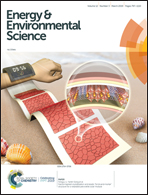Crossing the Thauer limit: rewiring cyanobacterial metabolism to maximize fermentative H2 production†
Abstract
Many cyanobacteria power metabolism during dark anaerobic conditions by the catabolism of glycogen which creates adenylate energy (ATP) and NAD(P)H. The latter can be reoxidized by a reversible NiFe-hydrogenase functioning as a terminal oxidoreductase generating H2 as byproduct. Theoretically, one glucose molecule can yield up to 12 molecules of H2, although this never happens in vivo. The thermodynamic preference is for glucose catabolism via the Embden–Meyerhof–Parnas (EMP) pathway (henceforth, glycolysis) which restricts the pathway yield below 4 mole H2 per mole glucose (so-called Thauer limit). An alternate route that is not used is the oxidative pentose phosphate shunt (OPP), which theoretically can yield 3-fold more NAD(P)H than glycolysis. Herein, we engineer the cyanobacterium Synechococcus sp. PCC 7002 to redirect glycogen catabolic flux through OPP by deleting the gap1 gene for glyceraldehyde-3-phosphate dehydrogenase (GAPDH-1) and stack this with a knock-out mutation of NADH-consuming lactate dehydrogenase (ldhA). The resulting Δgap1ΔldhA double mutant when combined with the elimination of H2 uptake by continuous electrochemical removal of H2 was able to produce 681 μmol H2 per g DW per day, equivalent to 6.4 mole H2 per mole glucose, well beyond the Thauer limit. This achieves the highest in vivo autofermentative H2 production yield of any bacterium, equivalent to 80% of the theoretical maximum of 8 H2 per glucose via OPP, using only photoautotrophically generated glycogen as precursor with full retention of cellular viability. These findings demonstrate the plasticity of central carbon metabolism and the significant potential of metabolic engineering for redirecting carbohydrate catabolism towards hydrogen production in cyanobacteria.



 Please wait while we load your content...
Please wait while we load your content...